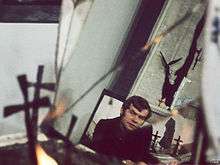Władysław Hasior
| Władysław Hasior | |
|---|---|
 Władysław Hasior | |
| Born |
May 14, 1928 Nowy Sącz, Poland |
| Died |
July 15, 1999 (aged 71) Kraków, Poland |
| Nationality | Polish |
| Education | Academy Of Fine Arts In Warsaw |
| Known for | Painting, sculpture |
| Notable work |
Wyszywanie Charakteru (1976 assemblage) Pamięci Dzieci Zamojszczyzny (1973 assemblage) |
Władysław Hasior (Polish pronunciation: [vwaˈdɨswaf ˈxaɕɔɾ], May 14, 1928 – July 15, 1999) was one of the leading Polish contemporary sculptors connected with the Podhale region. He was also a painter and theatre set designer.[1]
Biography
Władysław Hasior was born in Nowy Sącz on May 14, 1928. From 1947-1952, he studied under Professor Antoni Kenar at the State Secondary School of Visual Art Techniques. In 1952 he started his studies in sculpture at the Academy of Fine Arts in Warsaw. He graduated from the Academy in 1958. From 1959-60, he stayed in Paris as a holder of a scholarship of the French Ministry Culture and studied under Ossip Zadkine. His first individual exhibition was in 1961 at the Jewish Theater in Warsaw. Since then his works have been displayed at over seventy individual exhibitions in Poland and Europe. In 1968 Hasior had returned to his first school and became a teacher there until 1968.[1]
Hasior’s art meant to provoke and shock the beholder. He continuously experimented with forms, techniques and materials by creating spatial compositions, assemblages and collages. He also authored many unconventional monuments and plein air sculptures, both in Poland and abroad. Since 1984 artist focused on the continuous arrangement of the authors Gallery.[1]
Władysław Hasior died on July 14, 1999 in Kraków. He is buried at the Zakopane Cemetery of the Meritorious at Pęksowy Brzyzek.[1]
Hasior Museum in Zakopane
Gallery devoted to Hasior's work has existed since 1984 and is situated in the interior of the ‘deck-chair rental’ by the ‘Warszawianka’ Hotel, a building that was built prior to World War II when Zakopane was an antituberculosis resort and bed rest in the open air was a common form of treatment.[1]
Officially, Hasior’s Gallery is a branch of the Tatra Museum, which the artist enriched with a "dowry" of around one hundred of his works. They constituted the bases for the permanent exhibition made available to the visitors on the ground floor of the building. This is the exhibition which the host of gallery continuously developed and altered, building some kind of a total work, a unique installation of his own exhibits, he created a magical space imbued with music, light, and turned unreal with reflection of huge mirrors.[1]
Education
- 1947–1952, High school of Art Techniques in Zakopane
- 1952–1958, Academy of Fine Arts in Warsaw
Works
- Niobe (1961)
- series of Banners (1965–1975)
- Golgota (1971)
- Dark landscape (1974)
- Embroidery of Character (1974)
- Interrogation of Angel (1980)
Monuments
- For the rescuers in Zakopane(1959)
- Organ on Snozka pass near Czorsztyn (1966)
- Burned Pieta near Copenhagen (1972)
- Fire Birds” in Szczecin (1975)
- Fire Birds” in Koszalin (1977)
See also
References
Bibliography
- Anda Rottenberg, Teresa Jabłońska, Marek Pabis, Maciej Buszewicz, Magdalena Iwińska, Władysław Hasior, Olszanica 2004, publisher Bosz, ISBN 83-87730-93-9.
